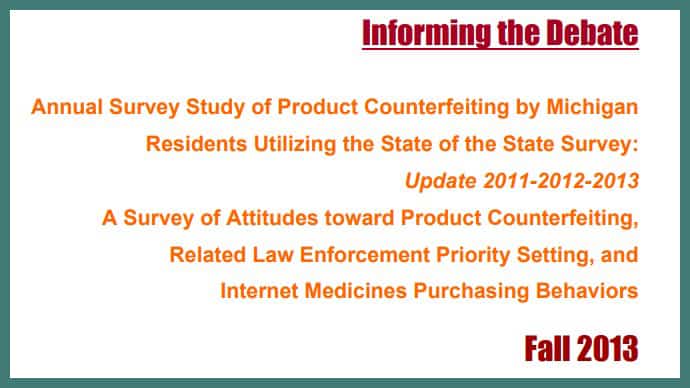There are important Law Enforcement priority-setting insights for Food Fraud in our recent “Annual Survey Study of Product Counterfeiting by Michigan Residents Utilizing the MSU State of the State Survey.” The surveys were conducted in 2011, 2012, and 2013. We have submitted for funding the continuation of the research. The next step would be a specific focus on public health-related products and, specifically, food.
This was the third year of an annual product counterfeiting-related study of residents in the State of Michigan. This was funded by the MSU IPPSR/MAPPR and utilized their annual State of the State Survey. The brief results from the three annual surveys are included. There is a specific note of the application to Food Fraud:
Attitudes Toward Product Counterfeiting. The rate of knowingly purchasing counterfeit products in their lifetime was 16% (non-deceptive product) with 10% have bought a product they later found was a fake (deceptive product).
- For Food Fraud: In general, residents do not seek fraudulent products.
Internet Prescription Medicines Purchasing Behavior. The number of residents who purchased pharmaceutical medicines legally with a prescription online grew from 4 to 8%. Those who illegally purchased prescription medicines online stayed consistent at 1%.
- For Food Fraud: Almost no residents knowingly illegally purchase products that have a public health attribute such as medicines – which also applies to food products. Residents did not seek medicines they knew to be counterfeit.
Related Law Enforcement Priority-Setting. It was found that 55% of Michigan residents thought the “government” should do “more” to combat product-counterfeiting and 71% of the overall sample did not support increased taxes to cover the additional activity. Also, of the 55% that thought the government should do more, 82% of them did not support diverting resources from other crime fighting activity and 76% of them did not support increased prison time if it meant other types of prisoners would be released.
- For Food Fraud: While this survey did not separate products that had a public health attribute or not, the findings apply to Food Fraud because the vast majority of Food Fraud incidents do not have an acute or chronic public health threat. It will be interesting to see how Food Fraud is positioned since high profile incidents such as horsemeat and melamine in infant formula and pet food created wide-spread consumer concern. Generally, the survey data suggests great challenges for product counterfeiting to receive and sustain resource allocation for investigation, enforcement, prosecution, and incarceration.
- Additional Discussion: The survey addressed all “counterfeit products” and did not separate out products with a public health attribute such as medicines and food. Overall there is a belief by the respondents that the government should do “more” to combat counterfeit products. As Food Fraud incident awareness increases, residents and stakeholders demonstrate a corresponding increase in a belief that the government should “do more.” The consumer concern is a factor in legislative and administrative branch attention. Most recently this is evident in Seafood Fraud related activities where a new Presidential Task Force was created, as well as recent CRS and GAO reports. At the same time, the survey demonstrated a lack of support for resource allocation to combat counterfeit products. This general lack of support for all product counterfeiting is applicable to Food Fraud incidents that do not have a public health threat – and many of the previous reports stated there was no or little threat (see the 1996 GAO report on Fruit Juice Adulteration). Food Fraud – and the sub-category of Economically Motivated Adulteration (EMA) – is just being defined as a public health threat. The very definitions and regulations are still under development. Since the base concepts are still under development the holistic and all-encompassing countermeasures are only just being conceived. Without the clear definitions and regulatory foundation, as well as unclear countermeasures, it is difficult to define the resource allocation needs, let alone discuss the allocations themselves.
The full report covers many concepts that are import for the discussion, including:
- Federal and State Intellectual Property Rights and Fraud Laws
- Classification in the Uniform Crime Code (Either Part I violent and property crimes, or Part II “less serious” offences such as “Forgery and Counterfeiting” and “fraud.” Note: “Forgery and Counterfeiting” is usually a misdemeanor and includes counterfeit currency, fake identify cards such as drivers licenses, and other commercial fraud.)
- Federal Prison Population (it is decreasing)
- Laws and Enforcement Challenges (including constrained and decreasing resources)
- Results of Federal IP Enforcement and Prosecution
- State Department of Correction Overview, Prison Population (decreasing), Cost of Incarceration (increasing), Parole Rates by Offenses (generally increasing), Criminal Court Dispositions (e.g. To prison, probation, jail, or other)
- Consumer Perception: Global Survey on Counterfeiting
Once Food Fraud is defined and prevention plans are in place, the next critical step will be seeking and receiving resource allocation. This survey provides some insight on the underlying issues, challenges, and opportunities. To develop a holistic and all-encompassing Food Fraud Prevention infrastructure we must think of the entire system including prosecution and public-policy resource allocation. JWS.
Reference:
Spink, J. (2013) Annual Survey Study of Product Counterfeiting by Michigan Residents Utilizing the State of the State Survey: Update 2011-2012-2013 – A Survey of Attitudes toward Product Counterfeiting, Related Law Enforcement Priority Setting, and Internet Medicines Purchasing Behaviors, Michigan Applied Public Policy Research Report, MSU, (Co-Principle Investigator: Heinonen, JA) Fall 2013.

